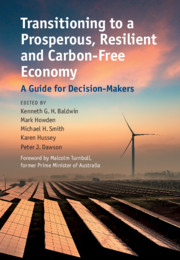Book contents
- Transitioning to a Prosperous, Resilient and Carbon-Free Economy
- Transitioning to a Prosperous, Resilient and Carbon-Free Economy
- Copyright page
- Dedication
- Contents
- Figures
- Tables
- Contributors
- Foreword
- Introduction
- 1 Policy Frameworks and Institutions for Decarbonisation: The Energy Sector as ‘Litmus Test’
- Technologies for Decarbonising the Electricity Sector
- Example Economies
- Cities and Industry
- 11 Cities
- 12 Buildings and Precincts
- 13 Urban Water
- 14 National Climate Change Adaptation Case Study: Early Adaptation to Climate Change through Climate-Compatible Development and Adaptation Pathways
- 15 Transport
- 16 Industry and Manufacturing
- Land Use, Forests and Agriculture
- Mining, Metals, Oil and Gas
- Addressing Barriers io Change
- Index
- References
16 - Industry and Manufacturing
from Cities and Industry
Published online by Cambridge University Press: 08 October 2021
- Transitioning to a Prosperous, Resilient and Carbon-Free Economy
- Transitioning to a Prosperous, Resilient and Carbon-Free Economy
- Copyright page
- Dedication
- Contents
- Figures
- Tables
- Contributors
- Foreword
- Introduction
- 1 Policy Frameworks and Institutions for Decarbonisation: The Energy Sector as ‘Litmus Test’
- Technologies for Decarbonising the Electricity Sector
- Example Economies
- Cities and Industry
- 11 Cities
- 12 Buildings and Precincts
- 13 Urban Water
- 14 National Climate Change Adaptation Case Study: Early Adaptation to Climate Change through Climate-Compatible Development and Adaptation Pathways
- 15 Transport
- 16 Industry and Manufacturing
- Land Use, Forests and Agriculture
- Mining, Metals, Oil and Gas
- Addressing Barriers io Change
- Index
- References
Summary
Industry is a major contributor to climate change. Many industrial sites, supply chains and customers are vulnerable to climate change and policy and consumer responses to climate change. Profits from industrial production depend on consumer demand, and how products are provided. Powerful forces such as digitalisation, dematerialisation, decentralisation, electrification, efficiency improvement and circular economies influence production and emissions Industrial firms face pressure from regulators, investors and customers. However, there is enormous potential to capture multiple benefits through aggressive, innovative decarbonisation strategies that target growth markets and involve cooperation along supply chains. Economic productivity and business competitiveness improvement can cut business costs and reduce extreme weather risk exposure, whilst positioning manufacturing companies for fast-growing markets in low-carbon resilient products and services. The chapter overviews policies national and subnational government policymakers can consider to support transition to a zero-carbon resilient industrial sector.
Keywords
- Type
- Chapter
- Information
- Transitioning to a Prosperous, Resilient and Carbon-Free EconomyA Guide for Decision-Makers, pp. 408 - 438Publisher: Cambridge University PressPrint publication year: 2021



